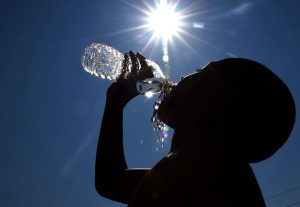With summer right around the corner, heat-related illnesses are on the rise. Sunburn and heat stroke are two common illnesses that can result from being exposed to high temperatures and too much sunlight. According to the CDC, the most heat-related deaths between 1999 to 2010 occurred between the months of May to September, with the highest heat-related deaths reported in July. Heat-related deaths and illnesses can be prevented with proper knowledge of their signs and symptoms. Here’s what to look for to stay healthy while enjoying the warm weather this summer.
Heat Exhaustion
Heat exhaustion occurs when your body is unable to regulate its internal temperature, causing it to rise. It can also exacerbate pre-existing conditions, like heart disease. Symptoms of heat exhaustion include
- Fatigue
- Headache
- Exhaustion
- Muscle cramping in the arms, legs, and abdomen
- Fainting
- Dizziness
- Shallow breathing
If left untreated, heat exhaustion can progress to heat stroke.
Heat Stroke
Heat stroke is a serious, potentially deadly heat-related illness. It occurs when your body is unable to regulate its internal temperature. High body temperatures can cause permanent damage to the brain and other vital organs, so it is imperative that heat stroke be treated immediately. The signs and symptoms of heat stroke are
- Confusion/Disorientation
- Hallucinations
- Agitation
- No sweating
- Hot, red, dry skin
- A body temperature of 104℉ (40℃) or greater
- Strong, rapid pulse
- Dizziness
- Nausea
- Unconsciousness
Heat Stroke Treatment
Heat stroke is a medical emergency that needs immediate attention. To help someone who is suffering from heat stroke, follow these steps while waiting for medical assistance to arrive
- Call 911
- Put ice on groin and armpit regions
- Cool the person off with fan and damp sheets
- Get the person in a cool bath or shower
- If conscious, rehydrate with sports drinks that contain electrolytes
Heat Stroke Risk Factors
People most at risk for having a heat stroke include
- Children under 4 years old
- People 65 years of age and older
- People with pre-existing medical conditions such as heart disease or diabetes
Heat stroke can also affect perfectly healthy individuals doing strenuous outdoor activities, or just being exposed to high temperatures indoors or outdoors. It is important to know the signs and symptoms of heat stroke in order to properly seek help if you or someone else is experiencing these symptoms.
Sunburn
Sunburn is another serious heat-related illness that can be prevented with proper care. Sunburn is caused by the sun’s harmful UV radiation. Too much exposure can cause your skin to burn, which can lead to health problems in the future. UV radiation can occur even on cloudy days, so it is important to use prevention year round. Symptoms of sunburn include
- Color changes to the skin
- Skin that is warm to the touch
- Painful skin
- Swelling skin
- Blisters
- Nausea
- Headaches
While there is no cure for sunburn, symptoms can be treated by applying cooling creams, such as Aloe Vera, to the skin. Anti-inflammatory medications, such as Ibuprofen or Aspirin, can be taken to reduce pain.
Sunburn Prevention
Prevention is the ultimate way to ensure your skin stays healthy while enjoying the outdoors.
- Avoid the sun between 10am and 4pm
- Cover up when in direct sunlight
- Apply SPF 30 or higher, and reapply after 80 minutes or after swimming
- Use sunglasses to protect your eyes
The long term effects of sunburn can be dangerous, resulting in cumulative, lifelong skin damage. Sun damage can cause wrinkles, changes in skin tone, and put you at risk for dangerous skin cancers such as melanoma.
Heat-related illnesses can be prevented by taking the proper precautions. Keep these warning signs in mind to stay safe and healthy all summer long.

